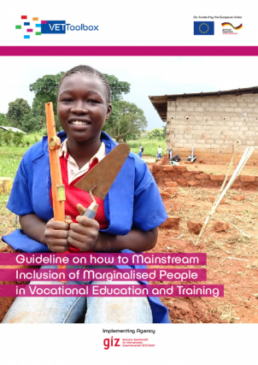Guideline on how to mainstream inclusion of marginalised people in vocational education and training
What is this tool about?
The Sustainable Development Goals (SDGs) and the slogan “leave no one behind” put inclusive development at a new level of attention for policy makers, bi- and multilateral donors as well as civil society. Talking about populations that are in danger of being left behind we mean girls and women; LGBTIQ; nomadic, pastoral, and rural societies; people living with HIV; persons with disabilities; refugees, street connected youth; and youth growing up in resource poor environments. An effective and verifiable way to increase the visibility of individual marginalised groups is to develop objectives and results with indicators for each marginalised group to ensure that they are included. This can only be achieved, if staff at donor organisations and implementing partners feel ownership for inclusive development and that no one is left behind in the project they plan and later implement.
How does it work?
This publication provides guidelines which shall help to get a holistic understanding about inclusive development related to VET. It offers an overview of “vulnerable groups” and sheds some light on internal and external barriers for inclusion, advises on how to develop inclusion policy for a VET institution, and highlights methodologies to ensure inclusion of marginalised learners. Furthermore, the guidelines draw the model of an inclusive labour market, describe the function of an inclusive job centre, and introduce relevant stakeholders to develop inclusive VET and an inclusive labour market.
Would you like to know more?
Download the full guide for free on this page or send us an email to info@vettoolbox.eu.





